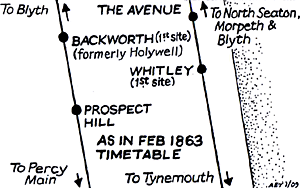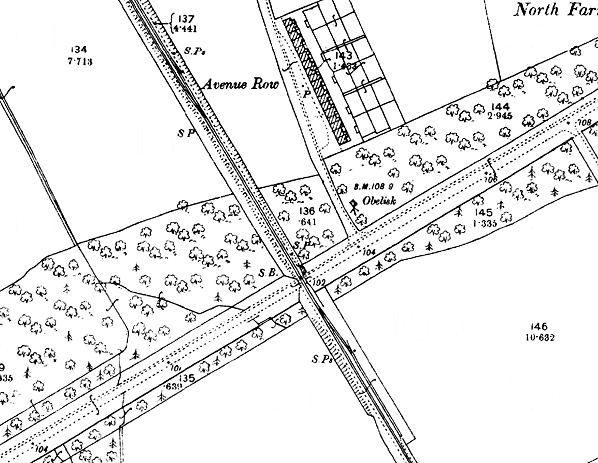Note: The Avenue was possibly served by Hartley Pit-Seaton Sluice trains. Its official life began in 1861 following the inauguration of the Hartley-Whitley service in 1860. In Bradshaw of February 1863 the Avenue, with the grand footnote ‘for Seaton Sluice and Delaval Hall’, was served by all trains – four each way on weekdays and two on Sunday.
From 1.4.1861 Dairy House station was named in the timetable, apparently renamed The Avenue some months later. Dairy House was over half-a-mile south of the Avenue, so it was possibly a different station. Dairy House might have been served by the short-lived Hartley-Seaton Sluice trains (1851-3).
After the closure of the Avenue Branch there is evidence of use of The Avenue on summer Sundays in 1872 and 1874.
BRIEF HISTORY OF BLYTH & TYNE RAILWAY (Hartley-Monkseaton ‘Avenue Branch’; Monkseaton / Whitley Bay / Tynemouth area)
| The southern end of the Blyth & Tyne Railway has a complicated history. Until 1861 there was a single route south from Blyth and Seghill through Prospect Hill to Percy Main, with a terminus adjacent to the NER station. However that year a new branch was opened, following the route of the former Whitley Waggonway, extending from Hartley to Tynemouth. It should be noted that this included the stretch to what is now Monkseaton, which was to be known as |
 |
the ‘Avenue Branch’, and that the line beyond to Tynemouth was half a mile inland of the present day Monkseaton – Tynemouth Metro line.
At the Tynemouth end the original terminus was quickly replaced with a new one on a short branch which curved south-eastwards, and that in turn closed when its branch was extended to a third terminus, which adjoined the 1847 Tynemouth terminus of what had been the Newcastle & North Shields Railway. These developments are shown on the series of accompanying maps.
 |
In 1864 the Blyth & Tyne reached Newcastle, with its terminus at New Bridge Street. This was achieved by diverting trains onto a new line just south of Holywell, through Backworth, Benton, and Jesmond. From Backworth a new line was opened to join the 1861 Whitley (Monkseaton) to Tynemouth route. Trains could now travel on the B&T from Newcastle (New Bridge Street) to Tynemouth, making the Holywell – Prospect Hill – Percy Main route, and the Avenue Branch between Hartley and Whitley (Monkseaton) redundant. These two lines closed in June 1864 on the day when the Newcastle – Tynemouth service was inaugurated. In June 1904 the Avenue Branch reopened to passenger traffic.
.gif) |
In 1874 the B&T was absorbed by the NER, and the opportunity was taken to reorganise the railway routes in the Monkseaton / Whitley / Tynemouth area. With the growth of housing and holidaymaking on the coast the ‘inland’ route from Monkseaton to North Shields was superseded in 1882 by one within sight of the sea, and the two formerly competing termini at Tynemouth were replaced with a splendid new through station. This created the coastal section of the familiar Coast Circle and Metro route, although there were to be realignments at Whitley Bay in 1910 and Monkseaton in 1915 where new, larger stations were built.
Click here for a list of sources and a Blyth & Tyne bibliography
1863 Bradshaw from Alan Young. Route map drawn by Alan Young.
To see other stations on the Blyth & Tyne Railway Avenue branch click on the station name: Dairy House, Monkseaton (1st site), Whitley, Cullercoats (1st site), Tynemouth (1st site), North Shields (B & T) & Tynemouth (3rd site)
See also Seaton Sluice and the unopened Collywell Bay branch: Brierdene & Collywell Bay
See also
West Monkseaton, Monkseaton (2nd site), Whitley Bay (1st site), Whitley Bay (2nd site), Cullercoats (2nd site) & Tynemouth (4th site)
See also
Tynemouth (Newcastle & Berwick terminus)
|

old1.jpg)

1.jpg)


.gif)

old3.jpg)
old2.jpg) Looking north at The Avenue crossing in 1966, two years after the line closed. The track south of the crossing looks recently lifted while track is still in place north of the crossing.
Looking north at The Avenue crossing in 1966, two years after the line closed. The track south of the crossing looks recently lifted while track is still in place north of the crossing.2.jpg)

 Home Page
Home Page